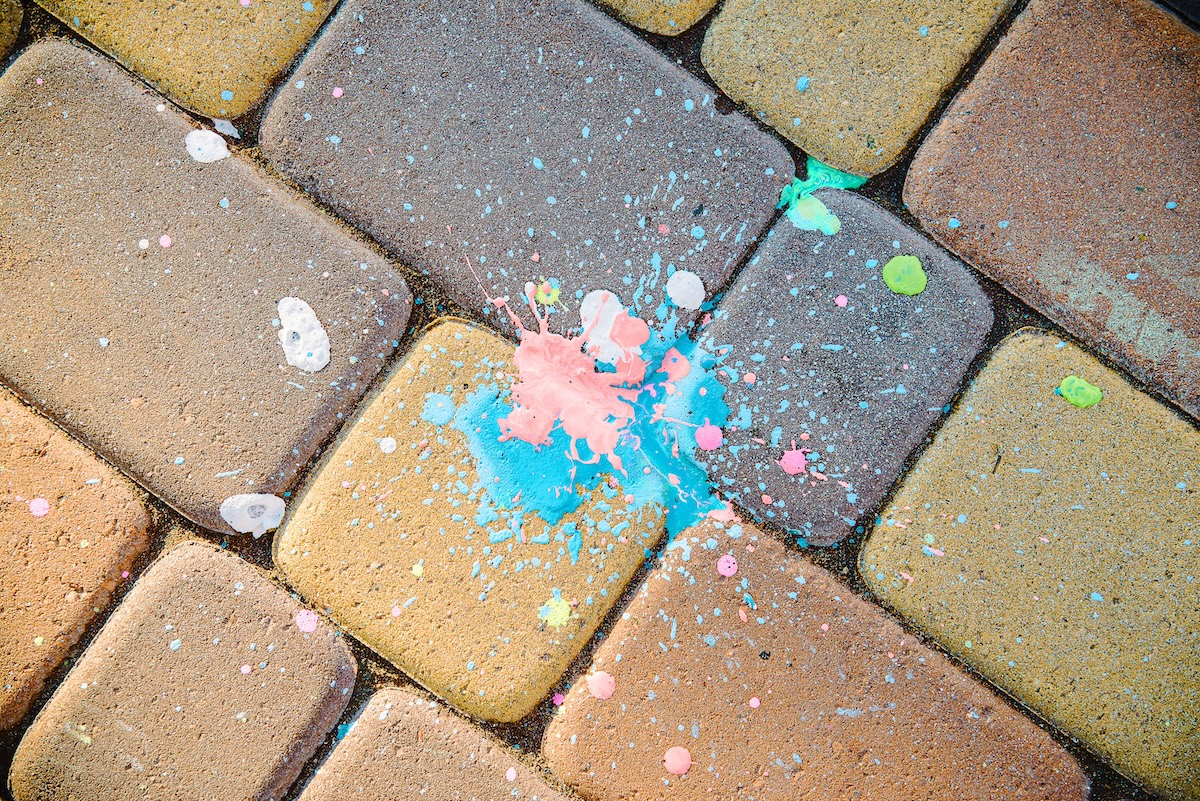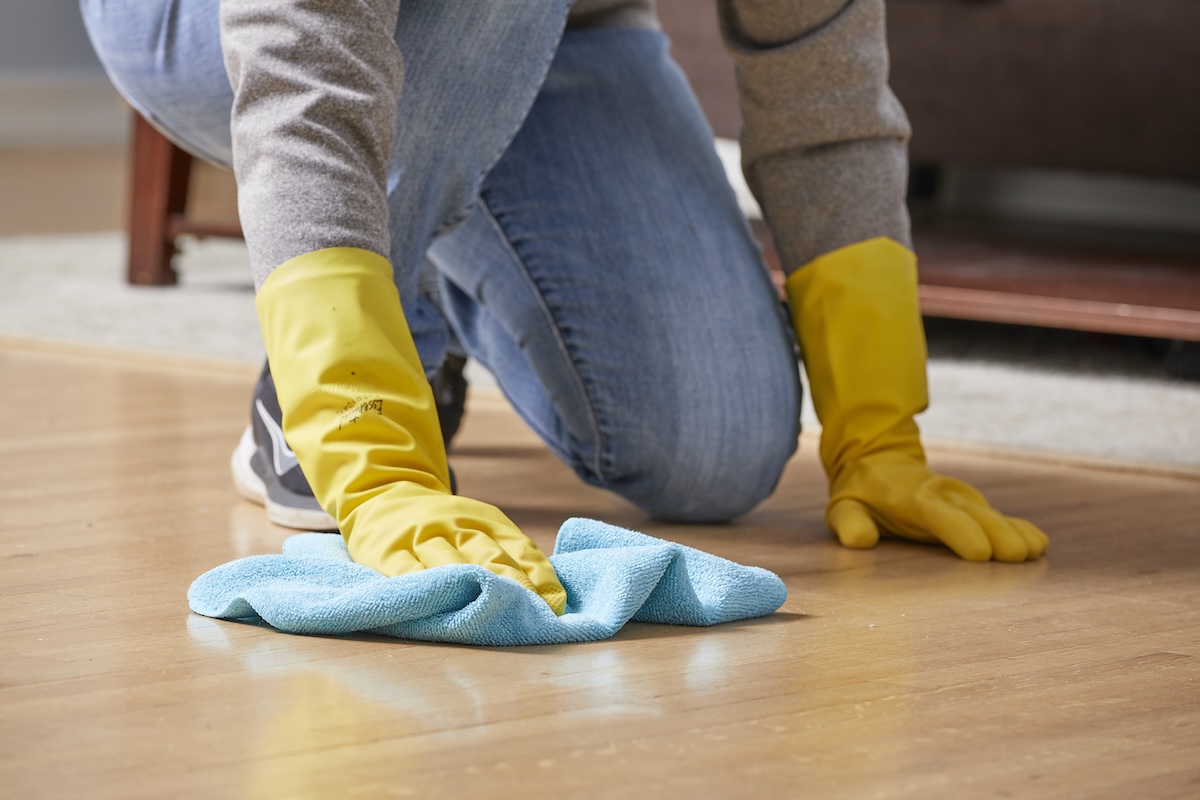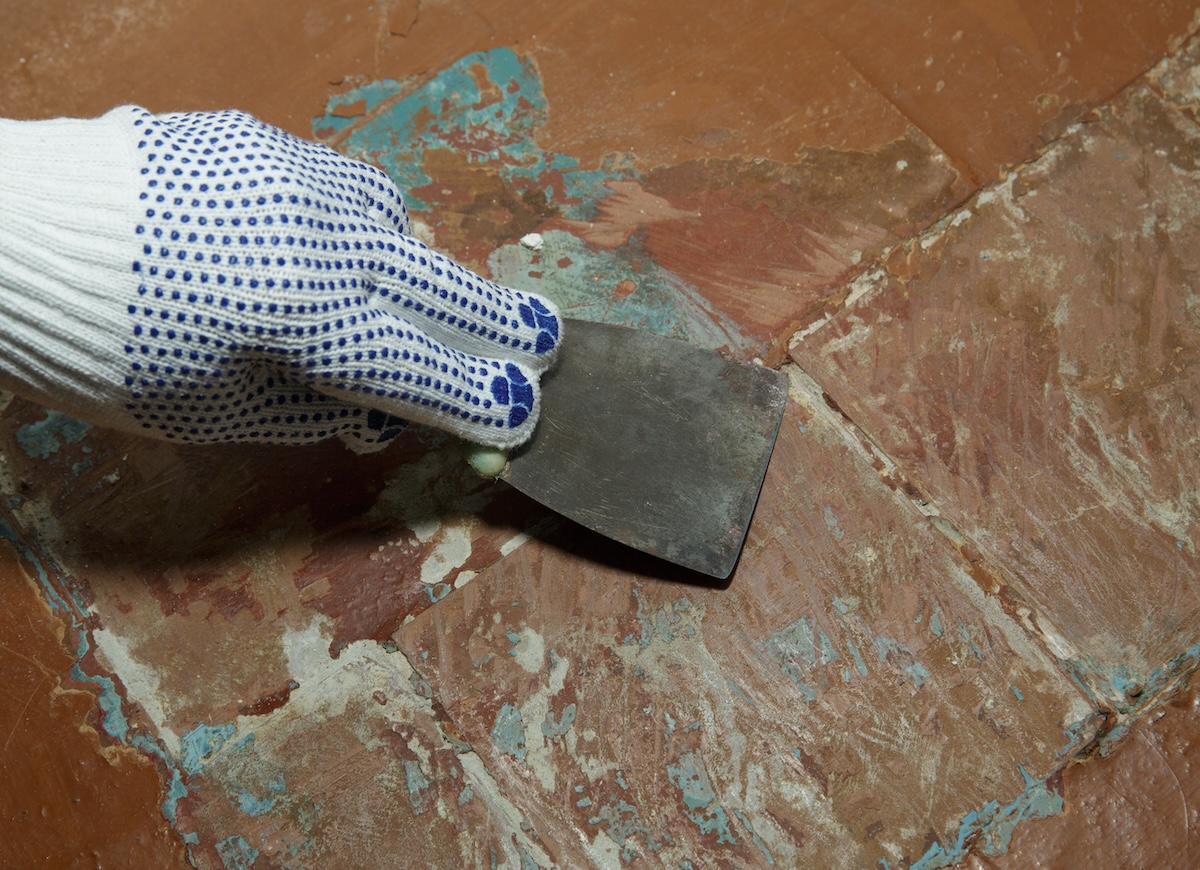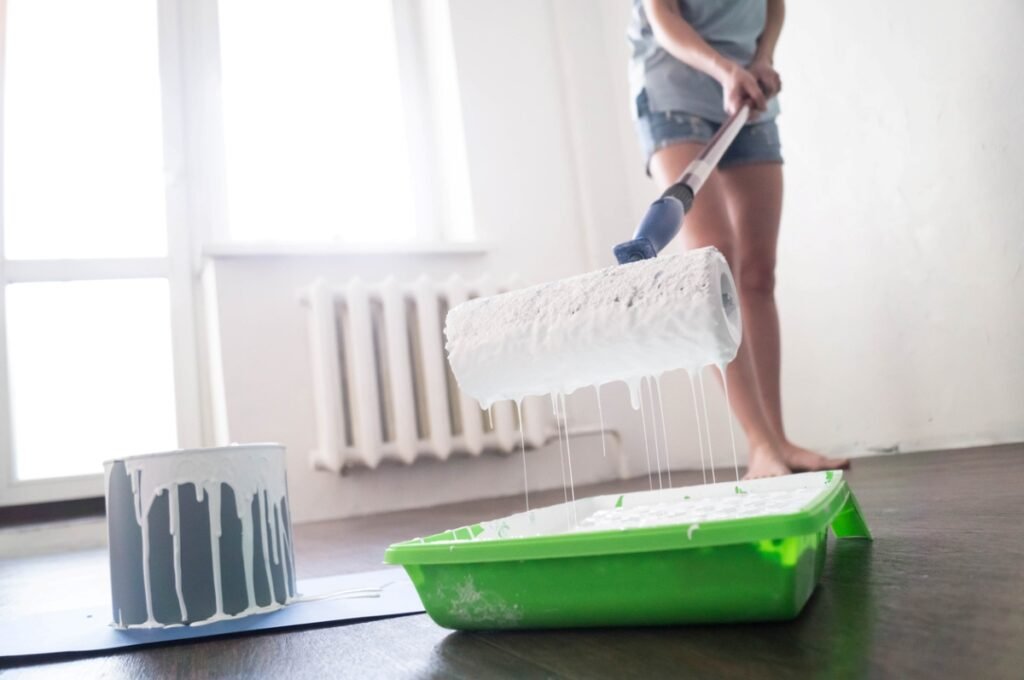Refreshing a room can be as easy as applying a fresh coat of paint to the walls and trim, but painting projects are potential sources of annoying spills and splatters. Even the most careful and experienced painters can find their efforts marred by drips on wood flooring, countertops, or carpet.
Fortunately, you can clean up most paint splotches with a few handy household cleansers and tools—microfiber cloths, rubbing alcohol, nail polish remover, and sometimes just plain water—along with a bit of elbow grease. But it’s essential to use the appropriate product and tools for each type of surface, and to remove paint methodically.
“Remember that paint should be removed in stages,” says Mike Lambertson, Purdy expert for Research & Development and Designer Applications. “You should work in the direction of the grain (especially on wood) to avoid leaving any gouges and minimize damaging the surface. Of course, safety should always be top of mind, so wearing gloves, dust masks, and safety goggles is highly recommended.”
Follow these helpful tips on how to remove paint from a variety of surfaces.
Types of Paint
The type of paint can determine the method needed to remove the paint from a surface. If it’s possible, always test a removal method on an inconspicuous area before attempting to eliminate the rest of the paint.
Oil-Based Paint
As oil-based paint has solvents, it will require a solvent to remove it from a surface. After gently scraping away any dried paint, try mineral spirits or a paint thinner to remove the rest.
Water-Based Paint
Latex and acrylic paints are the easiest types of paint to remove from most surfaces because they are water-based. Many splotches of latex or acrylic paint can be removed with just mild soap, warm water, a clean cloth, and a light pressure.
Spray Paint
Wet spray paint is easier to remove than dried spray paint. Usually you need only a mild soap and water to remove wet spray paint. However, dry spray paint may need the addition of WD-40 or rubbing alcohol.
Tools for Paint Removal
There are a variety of tools used to remove paint. “Tackle larger areas first using scrapers, then move on to the smaller areas or any rough patches with wire brushes or tools with a smaller scraping edge,” says Lambertson. “Once old paint is removed from your surface, be sure to wipe it down with a tack cloth or damp cloth to get rid of any debris. This will help the new paint or stain to adhere better and give you a smoother, more long-lasting finish.”
The following scraping and cleaning tools can remove paint. The list also includes the chemicals and solutions used to remove paint from a variety of surfaces.
Scraping Tools
Razor blade
Plastic putty knife
Plastic spoon
Steel wool
Carbide scraper
Wire brush
Utility knife
Cleaning Tools
Microfiber cloth
Sponge
Paper towels
Terry cloths
Toothbrush
Tack cloth
Solutions and Solvents
Dish soap
Glycerin
WD-40
Goof Off
Mineral spirits
Denatured alcohol
Paint stripper
Paint-removing gel
Detergent
White vinegar
Turpentine
Lemon juice
Baking soda
Removing Paint from Different Surfaces
Every type of household surface brings a new challenge for paint removal. Here are some of the most common surfaces and tips on how to be successful removing paint from each.
Clothes
Tools and supplies: Plastic knife or spoon, stiff brush, warm water, detergent, clean cloth
First, carefully scoop off any wet paint still on the fabric with a knife or spoon. If the paint has dried on the fabric, here’s how to remove dried paint from clothes. Scrape off any dried paint with a plastic knife or stiff brush. Run warm water on the back side of the fabric and blot the front with a clean microfiber cloth.
Next, make a 50/50 mix of detergent and warm water, then blot the fabric with a clean cloth. Apply stain remover if the fabric’s care label indicates that it’s safe, then launder the clothing as you usually would.
Wood
Tools and supplies: Carbide scraper, denatured alcohol, clean cloth, mineral spirits, wood finish repair pen, sandpaper, oil primer
Method 1: “When removing old paint, you should choose a tool based on the surface type. For example, with wood, look for a tool that removes the coating without damaging the wood beneath,” says Lambertson. “Purdy’s Premium Carbide Scraper is a great option for removing any coatings from wood furniture, trim and flooring, especially if you’re working with an older piece or a harder wood species. For finer finishes, the Premium 4-Edge Scraper is a great option that gives you flexibility with both coarse and fine edges.”
Method 2: Denatured alcohol, a clean cloth, and a lot of patience can remove latex paint from wood without damaging it. Oil-based paint splatters require mineral spirits, but the trick is not to soak the wood—too much of mineral spirits can damage the wood’s finish. Wipe it up thoroughly with clean water and let it dry once the paint is removed. If the wood becomes discolored, try touching it up with a wood finish repair pen like the Minwax Wood Finish Stain Marker.
Method 3: “If the expectation is to have all paint removed and a smooth appearance, I recommend either chemically stripping or mechanically grinding the surface to remove all or most of the existing paint,” says Erik Harris, owner of CertaPro Painters of Needham, Massachusetts. “Once completed, bare wood should be primed with a high-quality oil primer to ensure good adhesion for years to come.”
Concrete

Tools and supplies: Paint scraper, wire brush, paint stripper, pressure washer
“Concrete and brick are much tougher surfaces to prep since they are extremely hard, porous, and uneven,” says Harris. Paint spills on a concrete floor can be vanquished using commercial cleaners. Use a wire brush and then a paint scraper to loosen the paint, then vacuum up all debris. “If you’re working on a larger area like a deck or patio, the Block Wire Brush can be attached to the Purdy POLE+, which will help you save time,” says Lambertson. The extension also can reduce strain on your back and knees.
Apply a paint stripper such as Smart ‘n Easy Paint and Varnish Remover Gel. These products typically take 1 to 8 hours to work. Repeat the process as needed according to the product’s instructions. Finish the job by using a pressure washer to remove all traces of the paint stripper.
Brick

Tools and supplies: Paint-removing gel, fabric strips, nylon-bristle brush
It can be a challenge to remove paint from any type of brick. “If you’re removing paint from tougher, more textured surfaces like masonry, stucco, or brick, you’ll need a tool that can dig into the pits of these uneven surfaces, like Purdy’s Criss Cross Wire Brush,” says Lambertson.
According to Harris, scraping and sanding usually will work to some degree. “But it is very difficult to sand over an uneven surface. If removal of large amounts of paint is required, I recommend a chemical stripper,” says Harris. Use soft fabric strips and a paint-removing gel or paste like the biodegradable Dumond Chemicals Smart Strip Advanced Paint Remover, saturating the fabric with the gel, then placing it over the brick. Allow the product to stand as long as the manufacturer recommends, then when you peel off the fabric the paint should also peel away. Clean the brick’s remaining residue with a stiff nylon-bristle brush.
Metal
Tools and supplies: Baking soda, vinegar, water, pot, paint scraper; ammonia or acetone, microfiber cloth
Small metal items: For small metal items, start by mixing a solution of ¼ cup baking soda or vinegar and 1 quart of water. Bring the solution to a boil in a large pot, then add the stained metal pieces, boiling them for 15 minutes. Remove the items, place them on a heat-safe surface, and scrape off any remaining paint with a paint scraper.
Large metal items: If you need to remove paint from large metal areas or you have latex paint that’s tough to remove, use ammonia or acetone. Working in a well-ventilated area, dab a microfiber cloth into ammonia or acetone, then rub in a circular motion to gently remove the paint. If the paint stains are particularly stubborn, you can let the solution sit on the metal for a minute or two, then rinse with clean water.
Carpet

Tools and supplies: Paper towels, terry cloths, glycerin, white vinegar, nail polish remover, WD-40
It is easiest to remove paint from carpet before it dries, using dry paper towels or old terry cloths to blot—not rub—the spill. A bit of glycerin on the towels may help loosen the paint. To get rid of stubborn carpet stains or spills, try blotting with white vinegar or nail polish remover. Old paint drips might need the addition of a commercial cleaning agent, such as WD-40 or Goof Off.
Remember: When using any new cleaning agent, always do a spot test in an inconspicuous area of the carpet first.
Vinyl Floors
Tools and supplies: Dish soap, warm water, plastic scraper, rubbing alcohol, mineral spirits, liquid floor wax, wood cleaner
Removing paint from a floor without damaging the vinyl surface can be tricky. Start by mixing 1 teaspoon of dish soap with 3 cups of warm water, blotting up as much of the spill as possible. Remove stuck-on residue using a plastic scraper, using caution as you go. Ridding a vinyl floor of tough spills may require a solvent like rubbing alcohol or mineral spirits, but apply these cautiously because excessive use can dull the floor’s finish. For stubborn paint drips, very gently rub away the spots using liquid floor wax or a wood cleaner like Scott’s Liquid Gold and superfine steel wool.
Hardwood Floors

Tools and supplies: For water-based paint: Cotton ball, isopropyl alcohol; dishwashing soap, water, cup, microfiber cloth, lemon juice. For oil-based paint: Paint thinner, fan, microfiber cloth
First, determine whether you’re removing water-based or oil-based paint. If you’re not sure, test a small spot by dipping a cotton ball into isopropyl alcohol (rubbing alcohol), and wipe it over a small paint spot. If paint appears on the cotton ball, then you’re working with water-based or latex paint. If not, you have oil-based paint, which is trickier to remove.
Water-based paint: To remove water-based paint, add a few drops of dishwashing soap to 2 cups of water, then use a microfiber cloth to apply it to the paint. If stubborn stains remain, you can mix 3 parts rubbing alcohol with 1 part lemon juice, then apply it to the floor with a microfiber cloth.
Oil-based paint: For oil-based paint, you’ll need paint thinner such as turpentine. Making sure you ventilate the room well—open windows, and run a fan—and apply the paint thinner per the product’s instructions. Use a microfiber cloth to rub at the paint until it’s gone. Then clean the hardwood floor as you normally would.
Plastic
Tools and supplies: Vegetable oil, plastic putty knife, nail polish remover, denatured alcohol, dish soap, warm water
Many commercial paint removers can actually melt plastic. A better course of action is to use vegetable oil to soften paint on plastic, and gently scrape away paint drips with a plastic putty knife. For tougher spots, try nail polish remover or denatured alcohol, but first test a small patch to make sure the solvent does not damage the plastic. Clean off all traces of the solvent with dish soap and warm water.
Glass

Tools and supplies: Dish soap, warm water, sponge, razor blade
Dish soap and a safety razor blade can remove fresh or old, dried-on paint. Mix dish soap with warm water until sudsy, and thoroughly wet the window with a sponge or cloth. Hold the razor blade at a 45-degree angle, and carefully scrape the paint away. Keep the glass damp the entire time you are working to help avoid scratching the surface.
Leather
Tools and supplies: Microfiber cloths, white vinegar, leather conditioner
To clean leather furniture or other leather objects of paint, dip a damp microfiber cloth in white vinegar. Make sure it’s white vinegar and not another type; then gently wipe the cloth around the paint using circular motions. Let the vinegar solution sit on the affected area for a few minutes before wiping it away with a clean, damp cloth. Continue this process until all paint is removed. When you’re done, the leather might feel dry; apply a leather conditioner to rehydrate it.
Shoes

Tools and supplies: Microfiber cloths, white vinegar, rubbing alcohol, turpentine, leather conditioner; for canvas: warm water, toothbrush, dish soap, rubbing alcohol or turpentine
Leather shoes: White vinegar also can remove paint from leather shoes. Dip a damp microfiber cloth in white vinegar, then wipe the material around the paint using circular motions. Let the vinegar sit for a few minutes before wiping it away with a fresh, damp cloth. If paint remains, you can try adding some rubbing alcohol or turpentine. Just make sure to apply a leather conditioner when you’re finished to rehydrate your shoes.
Canvas: Cleaning canvas shoes to rid them of paint is a little simpler. Soak the shoes in warm water for a few minutes to loosen some of the paint. Use a toothbrush to apply a few drops of dishwashing detergent and water, scrubbing the affected areas until the paint is gone. If stains persist, try rubbing alcohol or turpentine.
Walls
Tools and supplies: Dishwashing soap, water, microfiber cloth, white vinegar, paint thinner
Your best bet to remove interior paint from walls is to mix a few drops of dishwashing soap in 2 cups of water, then dip a microfiber cloth into the solution and rub it on the walls, using gentle circular motions. Repeat the process until the paint is gone. You can also do this with 1 part white vinegar and 1 part water. If any paint remains or you’re dealing with oil-based paint, you might need to use a paint thinner, like turpentine, instead.
Countertops
While there are different methods for removing paint from different types of countertops, it’s always helpful to try to remove as much wet paint as possible. If you spill paint on the counter, use kitty litter or flour to contain the spill temporarily.
Tools and supplies: Borax, sponges, cornstarch, lacquer thinner
Granite: Mix warm water with borax and then apply it with a wet sponge on the paint. This can remove most of the paint. (For oil-based paint, mix cornstarch with water and wipe the area with a sponge or cloth.) Then sponge the counter with a clean wet sponge. If there is still paint on the counter, try using a small amount of lacquer thinner applied with a cloth.
Tools and supplies: Warm water, isopropyl alcohol, cloth, putty knife
Quartz: Mix 8 parts isopropyl alcohol to 1 part warm water and apply with a clean cloth. Then scrape the paint with a putty knife held at a 45-degree angle to the countertop. After the paint is gone, wipe with warm water.
Tools and supplies: Baking soda, warm water, cloth, putty knife
Laminate: Unlike stone and quartz, laminate is thin and delicate. Apply a mixture of baking soda and warm water to the paint, and then wipe with a clean cloth. For stubborn spots, wrap a cloth around a plastic putty knife, then scrape, exerting light pressure.
Tile

Tools and supplies: Razor blade or utility knife, cloth, white vinegar, water
For tile that’s durable and porous, you can use a razor blade or utility knife to gently scrape paint away. Use a damp clean cloth to moisten the area and help remove the paint flakes. For fragile tiles, a 50/50 solution of white vinegar and water can help remove the paint. Moisten a soft cloth with the solution, then lay the cloth on the paint-splattered area for a few minutes. Scrape the paint off with the knife blade.
Car Interiors
Tools and supplies: Microfiber cloth, white vinegar, rubbing alcohol
It’s not advisable to remove paint from your car’s exterior since you can damage the finish. That job is better left to the pros. But if you spill paint inside your car, you can tackle it in much the same way you’d handle removing paint from shoes.
To clean the interior, dip a damp microfiber cloth in white vinegar then wipe the affected area using circular motions. Let the solution sit for a few minutes before rubbing it off. If any paint remains, you can dip the cloth in rubbing alcohol and repeat the process until the paint is gone.
Paint Can Lid
Tools and supplies: Needle nose pliers, utility knife, multitool, multipurpose cleaner, cloth or toothbrush
It’s best to always wipe the rim of a can of paint before putting the lid back on to keep it clean, but, it doesn’t always happen. Any paint left in the rim’s ridges can dry and fuse the lid to the can. If the lid is stuck, try using needle-nose pliers to pinch it and peel it up around the rim. Slowly work your way around the rim until the lid separates from the can. You might need to use a utility knife to score any gummed-up paint.
Before replacing the lid, use the utility knife and multitool to remove the dried paint on the rim. When most of the paint is gone, use a multipurpose cleaner and cloth or an old toothbrush to scrub remaining dried paint bits before they fall into the can.
When to Call a Professional for Paint Removal
While you can attempt to remove paint from a variety of surfaces using the above advice, there are times when asking a professional might be the best idea. If you’ve gotten paint on a treasured heirloom, on an irreplaceable fabric, or on a large area of concrete or brick, the scope and pressure of success might be beyond a reasonable DIY job.
Also, if you are confident about handling solvent-based materials or aren’t sure how much pressure to put on a scraper to avoid risking dents or scratches in surfaces, it’s probably a good idea to ask a pro to take the reins of the paint removal mission.



